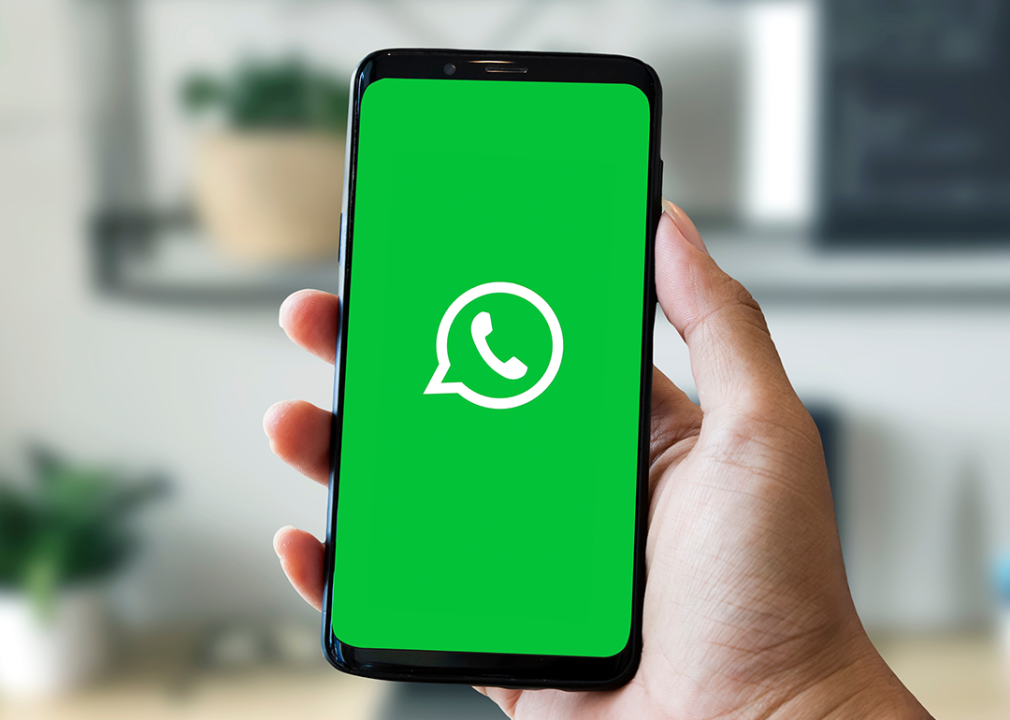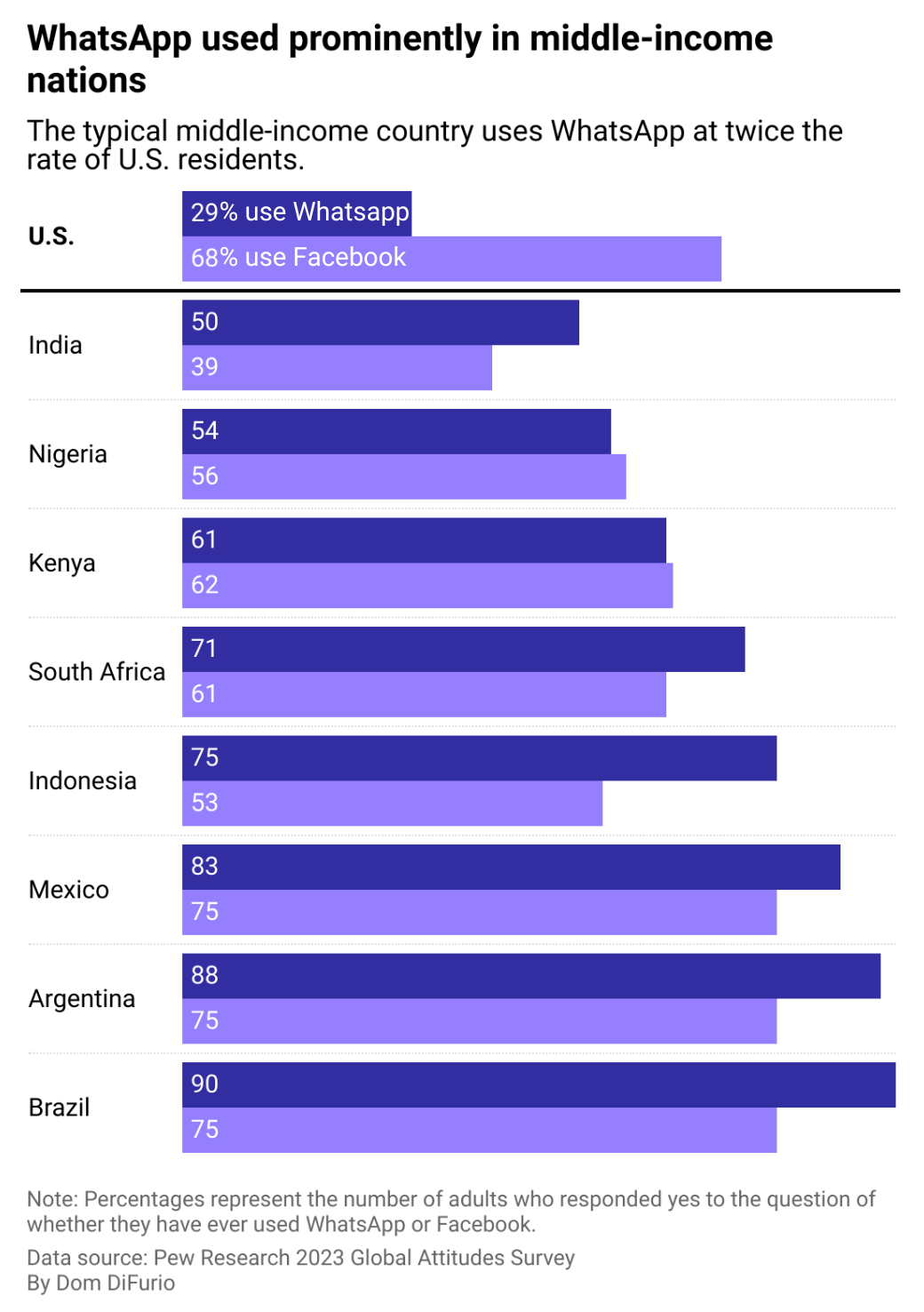Why one of the most popular apps in the world may finally be poised to take off in the US

dednuel images // Shutterstock
Why one of the most popular apps in the world may finally be poised to take off in the US
Hand holding a smartphone with a WhatsApp icon on a bright green screen.
WhatsApp is already the most popular way to message friends and family outside the U.S.—and it’s beginning to challenge iMessage’s blue bubble supremacy within the States.
Collabstr analyzed data from Pew Research and DataReportal to illustrate WhatsApp’s grip on internet users outside of the U.S. The analysis uses the World Bank’s country income groupings. Middle-income countries include India, the Philippines, Lebanon, Nicaragua, Mexico, Brazil, China, and dozens of others.
In 2023, across middle-income countries, Pew polling found that WhatsApp and Facebook were the most used media sites. WhatsApp has nearly 3 billion active users globally. Pew Research data indicates, however, that only 29% of U.S. adults are on the platform.
Recent reports suggest that may change as Americans discover its universality and as WhatsApp rolls out new features such as stickers and custom chat themes that can be more appealing to users. WhatsApp was the sixth-most downloaded app in the U.S. in 2023, seeing a 5% increase over the previous year, according to analytics firm Apptopia.
Statements from Meta CEO Mark Zuckerberg shared on the platform back up Pew’s estimates. According to Zuckerberg, nearly 1 in 3 people living in the U.S. use WhatsApp. The platform recently crossed the 100 million active monthly user mark in the U.S. at the end of July.
The push to attract more users in the U.S. market comes as Meta is also becoming more open-minded about breaking down walls between its apps and those of its competitors. The social media company recently made Threads, Meta’s X (formerly Twitter) competitor, compatible with the fediverse. The fediverse is a shared protocol that connects different social media networks that opt in. Networks like Threads, Mastodon, and Bluesky opting in can read posts and follow users on different fediverse apps regardless of the app or device used.
It’s a tactic Apple hasn’t been willing to adopt as it maintains a suite of services only available to iPhone and Mac users. Apple continues to dominate the U.S. phone market: Over 60% of smartphones sold in the U.S. are iPhones, according to market research firm Counterpoint.
But outside the U.S., where Android dominates the phone market, WhatsApp has a sizable hold on smartphone users.
![]()

Dom DiFurio // Collabstr
WhatsApp struggles to secure home screen spot on US phones
A grouped bar chart showing the percentage of adults in eight middle income countries who said they had ever used Facebook or WhatsApp. Brazil had the highest rate of WhatsApp users at 90%. The median middle income country response was 73% of adults saying they’ve used WhatsApp. In the U.S., just 29% of adults say they’ve used it.
In other middle-income countries, Pew data suggests that at least half of adults use WhatsApp for communication.
U.S.-based users were previously immigrants and families with international ties. As Americans traveled abroad at record-breaking rates in the years after the pandemic, they may have come across more people who primarily use WhatsApp to communicate. Survey data collected in May and June by Morning Consult also revealed that WhatsApp is commonly used by more affluent shoppers in the States: 37% of luxury shoppers used the service compared to 23% of all Americans.
Founded in 2009 and acquired by Meta in 2014, WhatsApp was largely left to its devices until 2019, when its parent company started focusing more on its potential. Part of that has included supporting businesses using its platform for marketing and customer service purposes. The company rolled out features allowing users to purchase things directly in the app in 2022. Meta also allows companies to hook their sales software up to WhatsApp to work as an instant messaging service akin to SMS marketing services.
The foundation of WhatsApp’s popularity globally was rooted in its being a free alternative to paid SMS and MMS plans offered by phone carriers, which can get pricey depending on the volume of messages sent. In the U.S., most phone plans have included unlimited text messaging bundled into their offers for at least the last decade. However, WhatsApp also offers an elevated, cross-platform messaging functionality that could find broader appeal with American smartphone owners fed up with their proprietary, built-in messaging apps.
For example, WhatsApp has benefitted thanks to Apple’s history of punishing iPhone users messaging Android users via the built-in messaging app iMessage. The company has ignored the painstaking experience of sending and receiving ultra-pixelated pictures and videos or trying to send group messages with Android users, something court documents revealed recently was a business decision intended to keep users from leaving the Apple product ecosystem.
WhatsApp offered a third option to users tired of those drawbacks, allowing for encrypted, online instant messaging, group messaging, and sharing of high-definition media using a phone number as the personal identifier—just like built-in messaging apps. The latest iOS 18 update finally aims to address several of those longstanding issues. However, lukewarm reviews of the update thus far may mean WhatsApp is still the best messaging option for people communicating between different devices.
As Meta continues to push new features to the app Zuckerberg has called “the private social platform of the future,” more Americans should be on the lookout for that green text bubble from a friend or family member asking them to move the conversation to WhatsApp.
Story editing by Carren Jao. Additional editing by Kelly Glass. Copy editing by Kristen Wegrzyn.
This story originally appeared on Collabstr and was produced and
distributed in partnership with Stacker Studio.
